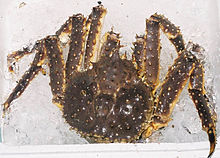Red king crab
| Red king crab | |
|---|---|
 |
|
| Scientific classification | |
| Kingdom: | Animalia |
| Phylum: | Arthropoda |
| Subphylum: | Crustacea |
| Class: | Malacostraca |
| Order: | Decapoda |
| Infraorder: | Anomura |
| Family: | Lithodidae |
| Genus: | Paralithodes |
| Species: | P. camtschaticus |
| Binomial name | |
|
Paralithodes camtschaticus (Tilesius, 1815) |
|
| External identifiers for Paralithodes camtschaticus | |
|---|---|
| Encyclopedia of Life | 342038 |
| ITIS | 97935 |
| NCBI | 6741 |
| WoRMS | 233889 |
| Also found in: , ADW | |
The red king crab, Paralithodes camtschaticus, also called Kamchatka crab or Alaskan king crab, is a species of king crab native to the Bering Sea. It grows to a leg span of 1.8 m (5.9 ft), and is heavily targeted by fisheries.
Red king crabs can be very large, sometimes reaching a carapace width of 28 cm (11 in) and a leg span of 1.8 m (5.9 ft). It was named after the color it turns when it is cooked rather than the color of a living animal, which tends to be more burgundy.
The king crab is native to the Bering Sea, north Pacific Ocean, around the Kamchatka Peninsula and neighboring Alaskan waters. It was introduced artificially by the Soviet Union into the Murmansk Fjord, Barents Sea, during the 1960s to provide a new, and valuable catch. The average temperature of the water for general survival of the crab is between 39 and 50 °F (4 and 10 °C). The crabs prefer to be in the lower temperatures, but can continue a stable lifecycle in the warmer temperatures. The depth at which it can live has much to do with what stage of its lifecycle it is in; newly hatched crab (larvae) stay in the more shallow waters where food and protection are plentiful. Usually after the age of two, the crabs move down to depths of 20–50 metres (66–164 ft) and take part in what is known as podding; hundreds of crabs come together in tight, highly concentrated groups. Adult crabs are found usually more than 200 m down on the sand and muddy areas in the substrate. They migrate in the winter/ early spring to shallower depths for mating, but most of their lives are spent in the deep waters where they feed.
It is the most coveted of the commercially sold king crab species, and is the most expensive per unit weight. It is most commonly caught in the Bering Sea and Norton Sound, Alaska, and is particularly difficult to catch, but is nonetheless one of the most preferred crabs for consumption.
...
Wikipedia
